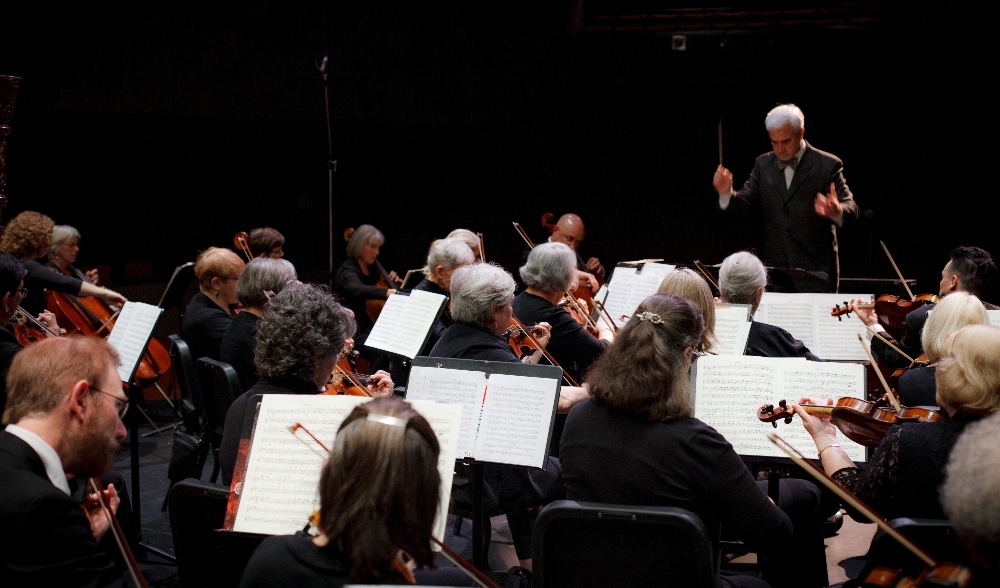“Once upon a time” begins the history of the Cascade Symphony Orchestra “…there lived in the land of South Snohomish County a group of musicians who had no orchestra.”
It was 1962 and Robert Anderson had resigned his position as conductor of the Bremerton Symphony Orchestra. Appropriately enough to the region, they played their last concert in the Navy’s shipyard. The end of the Bremerton orchestra gave birth to a new symphony orchestra later in 1962.
Sixty orchestra members under the baton of Robert Anderson created the Cascade Symphony Orchestra. Anderson lasted 30 years on the podium but never left his day job as head of music education in the Edmonds School District, then a rural enclave next to Seattle.
The Cascade Symphony, based in Edmonds, has since grown to 80 members with a unique longevity of its players. They have accumulated 1,504 years of service among the instrumentalists for an average of 18 years apiece. Few known community or professional orchestras can boast that kind of continuity.
Clydia Pappenfus, first violin, is in her 63rd year. She shares longevity honors with recently retired cellist emeritus Norma Dermond. (If you’re interested, the orchestra is auditioning for her cello position.)
On the short end of service is the new concertmistress Christina Wu, who is in her first year. She is also one of the rare professional ringers in the Cascade Symphony. A violinist since she was two, Wu studied in her native city of Wuhan China at the conservatory, and her family emigrated to the US. Concertmistress Wu also plays in the Seattle Symphony and is a charter member of the recently formed Madrona Quartet.
The Cascade Symphony is not a professional orchestra but instead is an orchestra of community instrumentalists who play for their love of music. The string and woodwind sections are almost all women except for two men the night of the concert I attended. The brass section was all male.
By 2002 amid Covid the costs and lack of funds nearly sank the Cascade Symphony after its founding director retired. The 2002-3 season was a resurrection season for the symphony. The threat of extinction helped Cascade musicians realize it was do or die.
Enter Michael Miropolsky, a violinist, who had escaped from post-Soviet Russia with one of his two violins and his wife. “We had no papers, and it was like we were from the moon,” Miropolsky remembers. He was an asylum seeker, which was granted. He then made his way to the violin section of the Seattle Symphony, director of the Seattle Virtuosi Chamber Orchestra, and a teacher at the University of Puget Sound. The Cascade musicians made Miropolsky their incarnation of their founding director, himself a violinist.
Norma Dermond, who shares the tenure record of 63 years as a founding member of the Cascade Symphony, said of Miropolsky: “Since his first rehearsal with us, there has been a real connection with him, and this makes the musicians very motivated to please him.”
Robert Anderson adds: “A community orchestra is the players.” The Cascade players run the orchestra, a trend becoming more common in larger professional orchestras too. As my colleague David Brewster recently reported, the Seattle orchestra’s new contract gives the players a strong role for any new hires, and veto power in the SSO’s current search choice for a new Musical Director.
Among the top ten orchestras in the world, the Berlin Philharmonic instrumentalists took control of their orchestra after the domination of its long-time musical Director Herbert von Karajan. More recently the Concertgebouw Orchestra members in Amsterdam decided to wait until 2026 to appoint their next Musical Director so they could have their choice: Klaus Mäkelå a 27 year-old musical wunderkind, when he becomes contractually available.
The concert season in Edmonds is short, three concerts in their “season” which makes Monday nights special. Monday is rehearsal night all year and orchestra members pledge themselves to that schedule. They come to play as much as they come to rehearse as to perform.
In performance you can hear the community nature of the orchestra. The joy of playing exceeds the level of intonation and virtuosity. This is not the Seattle Symphony or the now-professional Bellevue Symphony but it has a spirit of committed amateurs that makes the concert experience a special event.
A recent concert was ambitious. The first Symphony of Beethoven, the Strauss Horn Concerto #1 with the Seattle Symphony’s principle French horn player Jeffrey Fair as soloist. The concert concluded with Paul Hindemith’s Symphonic Metamorphosis on the themes of Carl Maria von Weber. The audience is largely local and loyal. The audience is the community and this is their orchestra.
The night I attended there was a nearly full hall at the Edmonds Arts Center, whose acoustics don’t help a symphony orchestra. Instead go to hear the goals that Maestro Miropolsky set when he took on his current post: “to bring the orchestra to the highest level, and the respect they had in the past. I want to make them happy and comfortable. These are very good players, including some great brass and woodwind players, and they practice very hard. We have the same values…. Music makes life more interesting, deeper, more satisfying. For me, and I hope for the musicians, this is a very pleasant period of life.”
Discover more from Post Alley
Subscribe to get the latest posts sent to your email.
